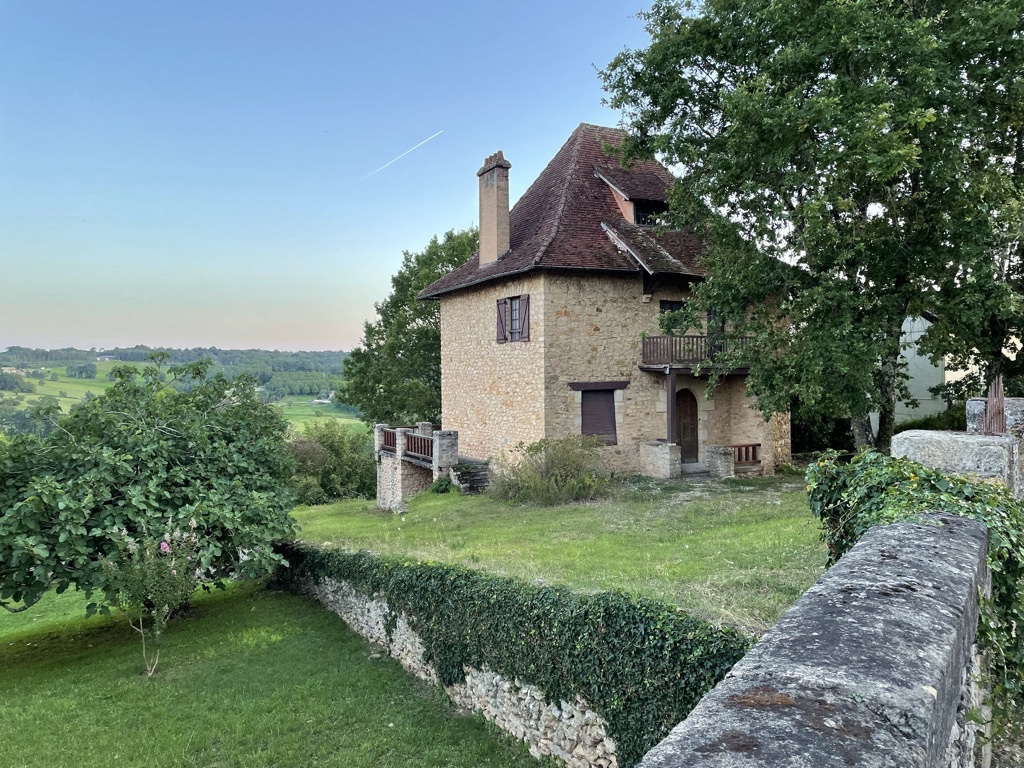
With all the confusion about red countries and different vaccination and quarantine requirements, the outlook wasn’t good for a foreign vacation this summer, so I decided to spend mine in France. No hardship there. The question was, where to go? Luckily, I have a friend with a house in the Dordogne, who kindly invited me to stay.

I have been to this lovely region, so popular with British and Dutch visitors, many times, but the part my friend’s house is located in, near the tiny village of Grives, was new to me. It is less touristy than château central not far to the east, where gorgeous castles like Beynac perch dramatically on cliffs overlooking the River Dordogne. I had the opportunity to discover new aspects of this green, walnut-growing region, where large-scale agriculture, which can easily mar a vacation with the noise of farm machinery and the odors of fertilizers and pesticides, is mostly absent.

One of the nearby gems I discovered during this stay was the picturesque and ancient fortified hilltop town of Belvès (now called Pays de Belvès to distinguish it from nearby villages with similar names), rated one of France’s “most beautiful villages” by the organization Les Plus Beaux Villages de France.

While not overrun by tourists, it has a few hotels (I stayed in the agreeable Le Home for a few days) and other accommodations, and several restaurants, making it a great base for a visit to the region. The town is also worth a stay for its own sake. Among its many points of interest is the Sunday market, held in the central square under a 500-year-old structure. When you go to the market, look up and note the chain hanging on high from the wooden beams – it’s the very chain from which malefactors were strung up and left to dangle in the public eye for a few days in medieval times, a humiliating punishment for their crime.

The place to have a drink and munch on some of your purchases after the market is the friendly Café des Sports right on the square, which sometimes hosts outdoor concerts.
Another attraction is the 14th-century Château de Belvès (aka, the Hôtel de Commarque), really the former home of a wealthy merchant, with its tower and garden and, most interestingly, recently uncovered murals dating from the Renaissance, one of which depicts the Nine Worthies – historical figures considered to be models of chivalry, first described in The Vows of the Peacock by Jacques de Longuyon – on horseback.
Around every corner is another beautiful centuries-old building or a gorgeous view of the valley of the Nauze River. The only restaurant that takes in the view is Le Parfum des Mets, with its varied menu, generous helpings and friendly service. More restaurants, cafés and the bakery can be found on the narrow Rue Jacques Manchotte, including the popular Planches et Plonk, which serves charcuterie and cheese platters and fine wines.

A nearby town worth visiting is Cadouin, with its Cistercian monastery founded in 1115, famous for its cloister, which became a pilgrimage site because it housed what was supposedly part of the Shroud of Turin, and the pretty little town of Siorac, which has a hotel/restaurant called the Relais du Périgord Noir, a good produce shop and not much else, but we found a lovely little grassy beach there on the Dordogne River (watch out for the currents!).
One cannot visit the Dordogne without taking a tour of its incredible caves decorated with prehistoric wall paintings. The original Lascaux caves near Montignac have been closed since 1963 to protect them from damage, but since then three impressive replicas have been created. Lascaux III is a traveling version, but Lascaux II and Lascaux IV are located next to Montignac. Lascaux IV, the most recent, is housed in a building designed by Norwegian architectural firm Snøhetta, which sits discreetly in a hillside but is rather spectacular inside.
Les Eyzies-de-Tayac, which bills itself as the “world capital of prehistory,” has a number of prehistoric sites to visit, many of them Unesco World Heritage sites, including the Grotte de Font-de-Gaume, one of the few caves with prehistoric wall paintings still open to the public in its original form.
After a two-week stay inland, it was time to go to the beach, so I headed to Saint Jean de Luz. Watch this space next week for Part II of my summer vacation.
Favorite
Thank you! I visited this area in the 1990’s and was very impressed with the chateau at Beynac. Its probably time to go back!
bonnie in provence